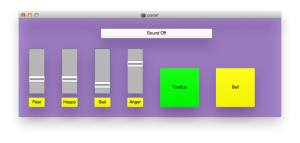I’m in charge of the sound and music for The Renegade Company’s upcoming theatre production. The company will reinterpret The Hunchback of Notre Dame in a silent movie style. There will be no dialogues in this nightmarish and grotesque version, and my electronic sounds will fill the space instead.
The director of the company proposed me to make a painful sound to reflect the main character’s suffering. The play is set in Quasimodo’s dream, and therefore the sound should also convey Quasimodo’s severe hearing damage as well as his emotional state. I imagine that many years of playing the church bell may have caused Quasimodo tinnitus or ringing in the ear.
The most challenging part of this project is that I will not be able to attend some of the shows as I will be 7+ hours away from the theater (a beautiful church in Center City Philadelphia). Despite this geographic challenge, I do not want to make a fixed audio file for this project. Instead, I want to make an easy-to-operate software that make unique sounds for each show. I also decided to focus on the emotional aspect of the characters.
The instrument I am building has four emotion sliders: fear, happy, sad, and anger. Each emotion currently has 3-4 different sounds that are controlled by corresponding slider. Also, there are buttons to turn on a sound that simulates tinnitus and trigger bell sounds.
Below is an example sound of what my current system can do. I improvised for about 6 minutes by combining different emotions as well as triggering tinnitus and bell sounds.
For the actual show, I expect that the sound guy will do the following tasks:
- Press emotion buttons whenever there is a scene or character change. The button will randomly trigger a sound. For example, Quasimodo’s happy sound could be different from Esmeralda’s happy sound.
- Increase the slider as the character’s emotion intensifies. For examples, if Quasimodo is little sad, put the slider to 30%. If Quasimodo is extremely sad, crank up the slider to 100%. The change in slider movement will change the “intensity” of the sound. There are many different interpretations of intensity in this software.
- Click Tinnitus button. The sound is very long and emotionally draining
- Click Bell button according to the play’s cue. The bell sound has an algorithm to play different resonances every each time.
There are many benefits of composing a software instead of recording tracks.
- The sound can response more flexibly to the character’s action, especially at improvised sections.
- The music sound different every time it is played. They will sound familiar, but the details will be different (think about a jazz pianist interpreting a standard. The pianist would play the same chord progression, but the actual resulting sounds are different every time).
- The software is easy enough to be operated by anyone. I shouldn’t have to be there to create sounds.
I’ll be meeting with the director in few days to show my progress. If the director likes the idea, I continue to work on it. I’m also waiting for the response of a percussionist. If he is available, there will be a live percussion accompaniment on top of the electronic part. If he’s unavailable, the sound needs to be a little more exciting.
Please feel free to let me know your thoughts on the sound and performance approach. Does it resemble the sound world of Quasimodo’s nightmare? Do you foresee any technical troubles?

